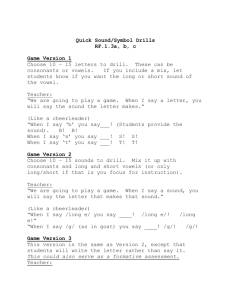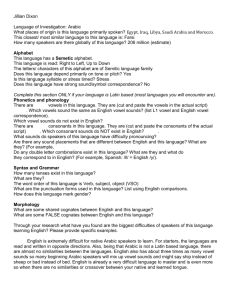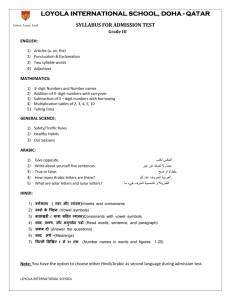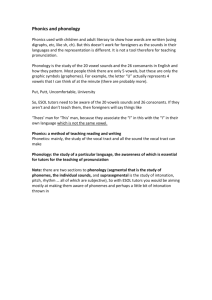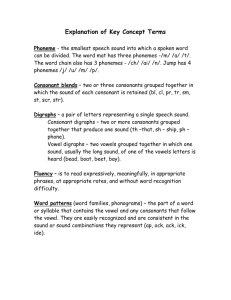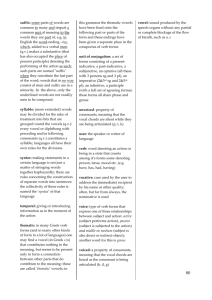LING 620 Proseminar/Thesis Formal Proposal Feedback
advertisement
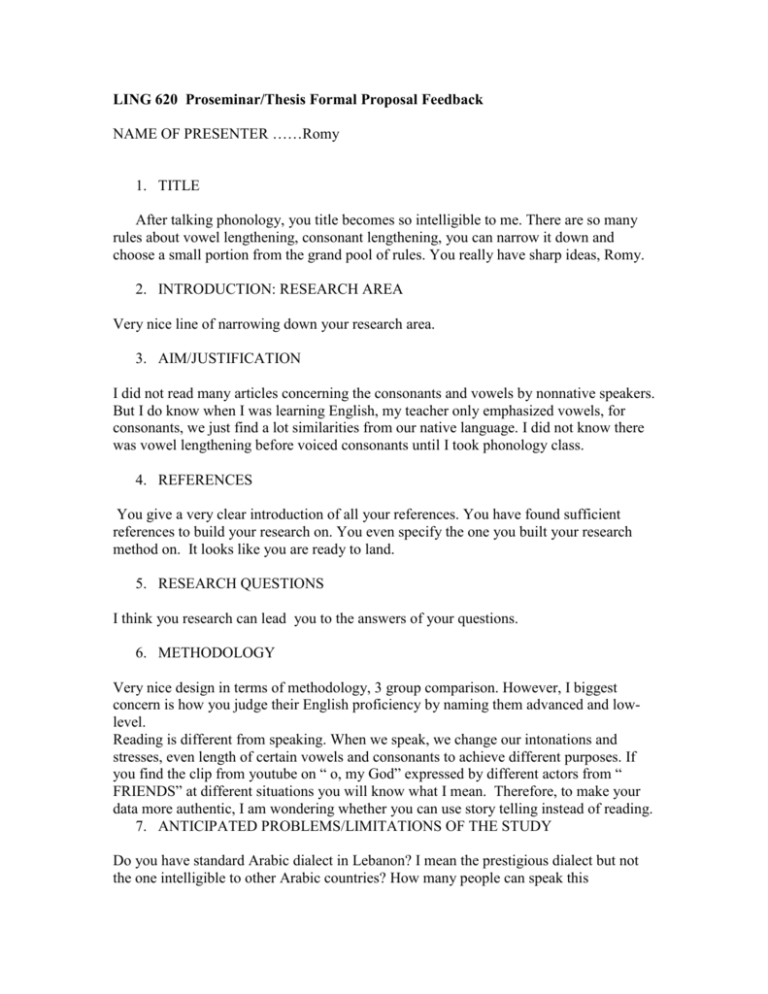
LING 620 Proseminar/Thesis Formal Proposal Feedback NAME OF PRESENTER ……Romy 1. TITLE After talking phonology, you title becomes so intelligible to me. There are so many rules about vowel lengthening, consonant lengthening, you can narrow it down and choose a small portion from the grand pool of rules. You really have sharp ideas, Romy. 2. INTRODUCTION: RESEARCH AREA Very nice line of narrowing down your research area. 3. AIM/JUSTIFICATION I did not read many articles concerning the consonants and vowels by nonnative speakers. But I do know when I was learning English, my teacher only emphasized vowels, for consonants, we just find a lot similarities from our native language. I did not know there was vowel lengthening before voiced consonants until I took phonology class. 4. REFERENCES You give a very clear introduction of all your references. You have found sufficient references to build your research on. You even specify the one you built your research method on. It looks like you are ready to land. 5. RESEARCH QUESTIONS I think you research can lead you to the answers of your questions. 6. METHODOLOGY Very nice design in terms of methodology, 3 group comparison. However, I biggest concern is how you judge their English proficiency by naming them advanced and lowlevel. Reading is different from speaking. When we speak, we change our intonations and stresses, even length of certain vowels and consonants to achieve different purposes. If you find the clip from youtube on “ o, my God” expressed by different actors from “ FRIENDS” at different situations you will know what I mean. Therefore, to make your data more authentic, I am wondering whether you can use story telling instead of reading. 7. ANTICIPATED PROBLEMS/LIMITATIONS OF THE STUDY Do you have standard Arabic dialect in Lebanon? I mean the prestigious dialect but not the one intelligible to other Arabic countries? How many people can speak this prestigious dialect? Will the speaker who can speak this prestigious dialect produce English sounds differently from those who can’t speak this prestigious dialect? . 8. EXPECTED FINDINGS As an nonnative speaker, I feel those who can speak very good English really have very good control of month opening and lengthening of vowels. I guess there is going to be a great difference 9. OVERALL COMMENTS phonology is so hard to teach, Romy you at only did very well in phonology class, today you will even demonstrate your favor to phonology by conducting a research for your graduation paper. I am very glad you will do one like this. I believe your search result will have great impact of language teaching. When Dr. Gordy decides to really enjoy retirement life, I wish you could come back and teach phonology courses at our department. LING 620 Proseminar/Thesis Formal Proposal Feedback NAME OF PRESENTER: Romy Ghanem 1. TITLE The title explicitly highlights the direction of the study. 2. INTRODUCTION: RESEARCH AREA The explanation of the key term is clear. Helping your listeners note the difference between vowel length in Arabic and English makes it easy to understand the significance of your study. However, it is not clear what determines whether a vowel is long or short in Arabic and whether this has an effect on the articulation of Arabic consonants, and by extension, articulation of English consonants. 3. AIM/JUSTIFICATION Good grounds for your study. Have you found other studies related to this topic onresearch Into other languages? on other languages? 3. REFERENCES Your choice of references is relevant. The last one looks pretty much like what you will be on with the exception of ‘physiological control’. More info on this one would help clear the difference between your study and Raphael’s study. Have you found other studies related to this on research into other languages? A comparison of your findings and others of the same kind might help back up your findings. 4. RESEARCH QUESTIONS Great questions. How do you make sure that your subjects give you their true TOEFL scores, and more specifically, the speaking score? 5. METHODOLOGY a. SUBJECTS/SOURCES The grouping is well thought out. My only concern is that you intend to have very few native speakers. Considering that they too have their variations (depending on dialect) in the production of vowels, sometimes diphthongizing what should not be or lengthening some that are short, you may need a bigger group of native speakers, then check on average, how they pronounce the vowels. This might make analysis of data easier than you have to compare group ½ with a group 3 where the latter has a variety of vowel lengths. b. MATERIALS/INSTRUMENTS Good. It is not clear whether you will have the minimal pairs together or individually at the end of a sentence. If you have the minimal pairs together, there is a possibility that the subjects will notice the words and be more conscious when they read them. Words that rhyme tend to draw attention to themselves. c. PROCEDURE Well stated. d. TYPE OF DATA AND ANALYSIS The reasoning behind having a wider scale makes a lot of sense, but I think the gap is too wide. 6. ANTICIPATED PROBLEMS/LIMITATIONS OF THE STUDY I do not see the third point as a problem. You have already identified your targetLebanese Arabic. Though there are many Arabic dialects in neighboring countries, you seem to suggest that Lebanese dialect is one and that is what you are investigating. I think the concern should be if your results could be generalized for all Lebanese Arabic speakers and not all Arabic speakers. . 7. EXPECTED FINDINGS I agree. 8. OVERALL COMMENTS I think your topic of choice is great. It will be interesting to hear what you find out. LING 620 Proseminar/Thesis Formal Proposal Feedback NAME OF PRESENTER ……Romy Ghanem 1. TITLE I think the title of the research is precise and to the point 2. INTRODUCTION: RESEARCH AREA The introduction part is clear; however, it would be better if she provided the exact vowels and consonants she is working on. 3. AIM/JUSTIFICATION The justifications that she provides seem to overlap a lot with the limitations of the study. So I’m a bit confused of what her justifications are. 4. REFERENCES It looks like most of the researches conducted on this particular area are quite old except a few of them. As Romy points out there have been several researches conducted on studying the sounds (vowels and consonants). Yet, few of them have studied vowels respectively. Romy is basing her study on Munro’s research. 5. RESEARCH QUESTIONS The research questions seem answerable and also interesting to be investigated. 6. METHODOLOGY Romy’s methodology seems very detailed and she seems to know what she wants from her participants. 7. ANTICIPATED PROBLEMS/LIMITATIONS OF THE STUDY Romy indicates three anticipated problems. However I have a question about one of the limitations she mentions “imbalance in levels of speakers” as she says that she will study different levels separately, will it still cause a problem in her research or does she mean that there will be imbalance among the groups? 8. EXPECTED FINDINGS The finding that Romy is expecting to find are interesting in a way that directs to the research and attracts curiosity. 9. OVERALL COMMENTS LING 620 Proseminar/Thesis Formal Proposal Feedback NAME OF PRESENTER ………Romy……………………………. 1. TITLE Intelligibility of Voiced and Voiceless Consonants Produced by Lebanese Arabic Speakers with Respect to Vowel Length 2. INTRODUCTION: RESEARCH AREA Are you examining these speakers speaking English or in Arabic actually? You might want to clarify this at the beginning. 3. AIM/JUSTIFICATION Really neat research area considering there hasn’t been much research done on vowel length but rather just production. That is a very big problem to study considering that could affect their intelligibility. 4. REFERENCES Very straightforward, seems like you have your sources straight. 5. RESEARCH QUESTIONS What do you deem advanced? Are you taking subjects from “advanced” classes maybe? 6. METHODOLOGY a. SUBJECTS/SOURCES I like how you have even numbers for all subjects and judges. b. MATERIALS/INSTRUMENTS Thanks for explaining PRATT, I have never heard of it before. c. PROCEDURE Very straightforward, keep in mind that native speakers could also differ in their vowel lengths depending on where they are from in the United States. d. TYPE OF DATA AND ANALYSIS I like how you have a control and experimental group to compare. Very good idea with not using the Lichert scale. I agree with the 0-100 scale. 7. ANTICIPATED PROBLEMS/LIMITATIONS OF THE STUDY . You should consider the different American dialects in your problems/limitations as well, unless you are planning on controlling your native speakers group to be from one area. 8. EXPECTED FINDINGS Very straightforward with this. No problems here. I agree with teaching phonology in classes, this is a problem in many countries, even here where they try to teach French or Spanish, but yet neglect overall intelligibility of the student while speaking. 9. OVERALL COMMENTS I would love to see your results, this is interesting! LING 620 Proseminar/Thesis Formal Proposal Feedback NAME OF PRESENTER: Romy 1. TITLE Good. 2. INTRODUCTION: RESEARCH AREA This is good. Not terribly complex even with a little phonology background. 3. AIM/JUSTIFICATION Also good. 4. REFERENCES These look completely appropriate and very well directed toward your research. 5. RESEARCH QUESTIONS You need to include “of English” after “speakers” in those. As they’re stated they’re confusing. 6. METHODOLOGY a. SUBJECTS/SOURCES As you say later, the TOEFL score is not directly related to only phonological production. So I wonder if maybe you could change it to length of time they’ve studied/spoke English? I think it’s a little less arbitrary, but could possibly suffer from mis-reporting. That said, the TOEFL at least provides some structure for selecting students. b. MATERIALS/INSTRUMENTS Good. c. PROCEDURE I like that you’re giving the raters a lot of granularity for their scores. Though I wonder if it’s a little too much. Maybe 0-50? I just don’t think many people would come up with a score of something like 43. What really makes it different from a 42 or 44? But perhaps that is good, just to give the raters that freedom. My other though is perhaps giving the raters some kind of guide would be helpful. Thinking of myself, I would struggle to know where the distinctions lie, especially at first. Now, what I think would be most useful here is some kind of normalization process to familiarize the raters with what they’re hearing and what the expected score would be. This is probably not feasible. So what I wonder might be a way to combat this is to have the raters hear each sample twice, but without their knowledge. That way, once familiarized with how they feel about scoring, they might change their score. I feel like these suggestions might be a bit bewildering and poorly-explained. Talk to me. Guess who. d. TYPE OF DATA AND ANALYSIS Fine. 7. ANTICIPATED PROBLEMS/LIMITATIONS OF THE STUDY I kind of addressed my TOEFL issue above. And obviously, you can’t really do all of accentedness, and I think this is a nice subset. 8. EXPECTED FINDINGS The second issue there seems a little weird to me. I guess because of the word “predict”, seeing as the TOEFL doesn’t “predict” their intelligibility, does it? Perhaps the score would imply a certain level? I’m not sure. 9. OVERALL COMMENTS This looks like a whole lot of fun, and like it should be really interesting. Good luck!
